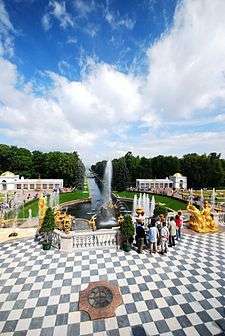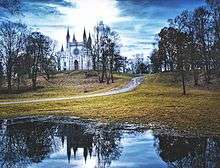Petergof
Coordinates: 59°53′N 29°54′E / 59.883°N 29.900°E
Petergof (Russian: Петерго́ф) or Peterhof (German and Dutch for "Peter's Court"), known as Petrodvorets (Петродворец) from 1944 to 1997, is a municipal town in Petrodvortsovy District of the federal city of St. Petersburg, located on the southern shore of the Gulf of Finland. Population: 73,199 (2010 Census);[1] 64,791 (2002 Census);[2] 81,525 (1989 Census).[3]
The town hosts one of two campuses of Saint Petersburg State University and the Petrodvorets Watch Factory, one of the leading Russian watch manufactures. A series of palaces and gardens, laid out on the orders of Peter the Great, and sometimes called the "Russian Versailles", is also situated there. The palace-ensemble along with the city center is recognized as a UNESCO World Heritage Site.

Palaces, fountains, and gardens



The dominant natural feature of Peterhof Grand Palace is a sixteen-meter-high bluff lying less than a hundred meters from the shore. The so-called Lower Gardens (Nizhny Sad), at 1.02 square kilometers (0.39 sq mi) comprising the better part of the palace complex land area, are confined between this bluff and the shore, stretching east and west for roughly 200 meters (660 ft). The majority of Peterhof's fountains are contained here, as are several small palaces and outbuildings. East of the Lower Gardens lies the Alexandria Park with 19th-century Gothic Revival structures such as the Gothic Chapel.
Atop the bluff, near the middle of the Lower Gardens, stands the Grand Palace (Bolshoy Dvorets). To the south of it are the comparatively small Upper Gardens (Verhny Sad). Upon the bluff's face below the Palace is the Grand Cascade (Bolshoy Kaskad). This and the Grand Palace are the centerpiece of the entire complex. At its foot begins the Sea Channel (Morskoy Kanal), one of the most extensive waterworks of the Baroque period, which bisects the Lower Gardens.
St. Petersburg State University
Besides the downtown campus, certain Saint Petersburg State University's schools and departments are located in Petergof:
- Graduate School of Management's campus in Mikhailovka (under reconstruction);
- Faculty of Biology and Soil Studies' research center in Sergievka (Leuchtenberg Palace);
- Petrodvorets Complex that includes four faculties:
- Applied Mathematics and Control Processes,
- Chemistry,
- Mathematics and Mechanics,
- Physics;
- seven research institutes:
- Astronomy,
- Chemistry,
- Computational Mathematics and Control Processes,
- Laser Research,
- Mathematics and Mechanics,
- Radiophysics,
- Physics;
- as well as 12 dormitories and a number of infrastructure objects.[4]
The Petrodvorets Complex dates back to 1960s when it was decided to copy best international practices and create a brand-new suburban campus for the University that experienced crucial need for new premises. Yet, the idea was said to be widely opposed by the faculty who did not want to commute two hours a day, and as few as four faculties were relocated to Petergof.[5]
In 1990s, the number of students from other regions fell significantly, and the University sold many of its downtown dormitories. When the trend reversed, the need for housing made the University administration accommodate most students in Petergof, even those from downtown faculties, which has created certain tensions. Yet, the idea of a suburban campus seems to be persistent, as the Government of the Russian Federation has decided to hand over the Mikhailovka estate to the University to reconstruct it and house the Graduate School of Management's campus.[6]
Due to the extensive presence of research facilities, mainly belonging to St. Petersburg State University, Petergof was named a naukograd in 2005.[7]
Petrodvorets Watch Factory
Russia's oldest factory was founded by Peter the Great in 1721 first as a lapidary plant to help in the construction of the Peterhof Palaces but also other Palaces in St. Petersburg. It started producing equipment and parts for the watch industry in the 1920s. After World War II, the factory started to fully produce watches under the brand name Pobeda and from 1961 under the brand Raketa. in 1985 the factory had 7500 employees and was producing 5 millions mechanical watches per year. As of today it is the last watch factory in Russia producing its own movements from A to Z, though the production is much smaller than it used to be.[8][9]
Transportation

The town is served by three railway stations (Novy Petergof, Stary Petergof, and Universitet). The palaces of Peterhof are accessible by sea via hydrofoils based near the Winter Palace in St. Petersburg. The palace is also easily accessed by road. Public transit and private van services make regular trips from Saint Petersburg.
The Upper Gardens are freely accessible, but entry to the Lower Gardens requires the purchase of tickets (not included in the boat fee for visitors arriving by hydrofoil). The palaces and grotto are accessible only as part of guided tours.
Sister cities
References
- ↑ Russian Federal State Statistics Service (2011). "Всероссийская перепись населения 2010 года. Том 1" [2010 All-Russian Population Census, vol. 1]. Всероссийская перепись населения 2010 года (2010 All-Russia Population Census) (in Russian). Federal State Statistics Service. Retrieved June 29, 2012.
- ↑ Russian Federal State Statistics Service (May 21, 2004). "Численность населения России, субъектов Российской Федерации в составе федеральных округов, районов, городских поселений, сельских населённых пунктов – районных центров и сельских населённых пунктов с населением 3 тысячи и более человек" [Population of Russia, Its Federal Districts, Federal Subjects, Districts, Urban Localities, Rural Localities—Administrative Centers, and Rural Localities with Population of Over 3,000] (XLS). Всероссийская перепись населения 2002 года [All-Russia Population Census of 2002] (in Russian). Retrieved August 9, 2014.
- ↑ Demoscope Weekly (1989). "Всесоюзная перепись населения 1989 г. Численность наличного населения союзных и автономных республик, автономных областей и округов, краёв, областей, районов, городских поселений и сёл-райцентров" [All Union Population Census of 1989: Present Population of Union and Autonomous Republics, Autonomous Oblasts and Okrugs, Krais, Oblasts, Districts, Urban Settlements, and Villages Serving as District Administrative Centers]. Всесоюзная перепись населения 1989 года [All-Union Population Census of 1989] (in Russian). Институт демографии Национального исследовательского университета: Высшая школа экономики [Institute of Demography at the National Research University: Higher School of Economics]. Retrieved August 9, 2014.
- ↑ "Portal of St. Petersburg State University".
- ↑ "History of Petrodvorets Complex (in Russian)".
- ↑ "GSOM's campus in Mikhailovka (in Russian)".
- ↑ "Naukograd Petergof (in Russian)".
- ↑ Documentory about the History of the Petrodvorets Watch Factory "Raketa", Russian with Eng subtitles.
- ↑ facts and articles about the History of the Petrodvorets Watch Factory "Raketa", in Russian and English.
- Vernova, N (2004). Peterhof: The Fountains. St. Petersburg: Abris.
- Vernova, N (2004). Peterhof: The Grand Palace. St. Petersburg: Abris.
External links
| Wikimedia Commons has media related to Peterhof. |
| Wikivoyage has a travel guide for Peterhof. |
| Wikisource has the text of the 1911 Encyclopædia Britannica article Peterhof. |
- Peterhof's official site
- Institute of Physics
- Official site of the Peterhof Watch Factory
- Official website of the museum
- Peterhof (Petrodvorets) – a Gardens Guide review
- Peterhof: history of gardens and town (Russian)
- Russian TV program about the 300 years of the Petrodvorets Factory (In Rus with Eng subtitles)
Further reading
- King, Greg (2006). The Court of the Last Tsar (hardback). Hoboken: John Wiley & Sons. pp. 559 pages. ISBN 978-0-471-72763-7.


